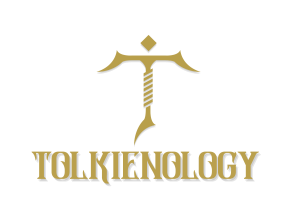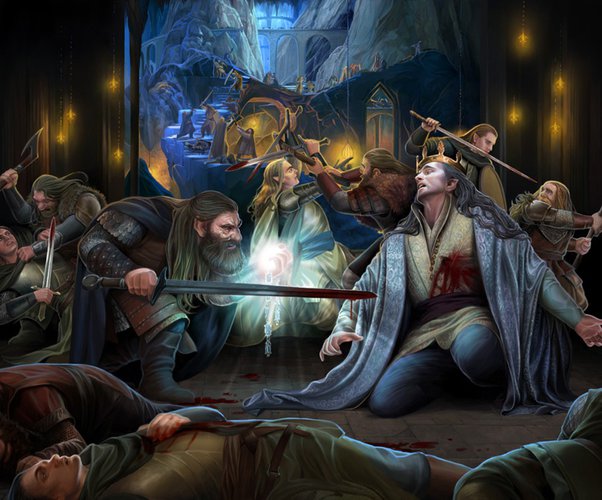If you have kept up with Amazon’s The Rings of Power, you are well aware of the arrangement between the elves of Eregion and the dwarves of Khazad-dûm. The gifted dwarven smiths are commissioned — through the diplomacy of Elrond with his friend, Durin IV — by Celembrimbor and the elven smiths of Eregion to construct a tower. This tower needs to be completed by spring, and it is being constructed to hold a forge that will be used to create a power greater than anything in Middle-earth, which ends up being the namesake of the show itself, the Rings of Power that end up causing a lot of trouble for the peoples of Middle-earth — though they do lead to some pretty good stories, such as The Hobbit and The Lord of the Rings.
The alliance between dwarves and elves alone is a great achievement. Indeed, it is said that elves and dwarves working together to construct this tower is one of the great achievements of the world. Based on comments in the show, this makes sense. Durin IV makes two statements that imply a strained relationship between the two proud people: Before Durin’s competition with Elrond in episode 2, Durin says, “There can be no trust between hammer and rock. Eventually, one or the other must surely break,” with the “hammer and rock” as symbols for the dwarven and elven people; in episode 5, Durin makes a comment that it is good to know that there is still some honor among the elves, implying doubt on his part that the elves have any honor at all remaining. In episode 5, Gil-galad seems to care little for Elrond’s oath to Durin and the dwarves to keep their discovery of mithril a secret. Sure, it makes sense for Gil-galad, the king of the elves of Lindon, to put the needs of his people above those of the dwarves, but his claim upon the contents of their homeland — a claim based on shaky grounds that Elrond describes as “apocryphal” — implies that he doesn’t consider them to be equals in the overarching affairs of Middle-earth, nor their needs equal to theirs.
If The Rings of Power (hereafter written as RoP) has introduced you to Tolkien’s Legendarium (the body of Tolkien’s works about Middle-earth), first, I want to say that being introduced to Tolkien this way is perfectly fine; I have read Tolkien for 20 years now, and I was introduced through Peter Jackson’s films back in middle school. Second, and most important for this article, you may be asking a great question: Have dwarves and elves always had a difficult relationship? The answer is “yes,” but it’s also complicated and needs quite a bit of foundational lore to fully understand. After introducing the origins of the dwarves and elves, I’ll explore one of the first examples of tension between the two races, which was likely in the minds of the show runners when they developed their adaptation of Tolkien’s writings of the Second Age of Middle-earth. So, as you might have guessed at this point, since RoP takes place in the Second Age, we’re going to take a trip to the legends and tales of the First Age of Middle-earth …
History of the Dwarves & Elves
One of the most important things to understand about Tolkien’s Legendarium is that it is essentially a mythology. Like the mythologies of the real world, such as Norse, Greek, Roman, Native American, or Polynesian, Tolkien’s mythology contains stories that describe the creation of all things, as well as explanations for why they are the way they are. For example, the destruction of the two trees of Valinor (as briefly shown in the prologue of RoP) is the explanation for the creation of the sun and moon, similar to the Polynesian myth about Maui stopping the sun in its tracks and chopping off its legs as an explanation for why days are as long as they are. Like the Norse and ancient near eastern myths, the creation myths of Tolkien’s mythology are violent, with rebellion and competition between “gods” as the vessel by which different races and lands are created. Also, similar to the Hebrew story of Lucifer rebelling against God, Tolkien’s mythology has Melkor rebelling against the Valar and causing a rift in the music of creation, which leads to evil. Melkor becomes known as Morgoth, who, as you know, is the original Dark Lord and is referenced throughout the first season of RoP.
Tolkien’s mythology contains detailed creation accounts for the races of Middle-earth, especially the elves, dwarves, and men. According to the opening sections of The Silmarillion (a book that could be described as “the Bible” of Middle-earth, the book that contains the myths on which the characters in Tolkien’s stories often look back), the dwarves were created out of a conflict between two gods. Ilúvatar, the “Supreme being,” created two races that were considered his children: the elves and men. However, Mahal, known as Aulë the Smith, was a Vala who decided to create his own race: the dwarves. You might recognize the name, Aulë (pronounced as ‘owl-ā’, as the name is often invoked by Durin IV and Disa in RoP in the form of “Aulë’s beard,” which could be a dwarvish equivalent to “Jesus Christ!” The problem with Aulë’s creation was that he was not granted the powers to create independent life, so Ilúvatar forced him to destroy his creation. In the end, Ilúvatar had pity on Aulë and his dwarves, so he allowed them to live, but he did not allow them to be woken until after the elves and men were awake. Therefore, from the very beginning, elves (and men) were favored by the supreme being of Middle-earth whereas he allowed the dwarves, who could be viewed as lesser creations since they had a lesser creator, to live only because Ilúvatar had pity on them. Knowledge of this origin would definitely cause some tension between the “chosen ones” and the ones who were almost murdered before they even had a chance to live.
Thingol & the Dwarves of Belegost and Nogrod
The origin of the elves and dwarves is enough to cause some conflict between the two races, but another story in the annals of Middle-earth history is more likely the root of this tension — a story that closely resembles a plotline that gained some steam in season one of RoP. Many centuries before the events of RoP, during the First Age, there was a great elven king named Thingol. He was one of two kings of the Teleri elves and the king of Doriath. Thingol was also the father of Lúthien, whose romance with the human Beren is one of the most popular stories — one of the “Great Tales” — in Tolkien’s Legendarium; also, through Lúthien, Thingol was the great-great-grandfather of Elrond, a major character in RoP. Another connection to one of the Great Tales, The Children of Húrin, is that Thingol became the foster parent of Húrin’s son, Túrin. But the story of Thingol relevant to RoP involves his dealings with the dwarves and one of the coveted Silmarils.
Thingol commissioned the dwarves of Belegost to carve the capital city of Doriath, the caverns of Menegroth. This started a positive relationship between the two races. However, a Silmaril got in the way of that relationship. Many years after the carving of the caverns of Menegroth, Thingol asked the Nogrod dwarves to place a Silmaril into the Nauglamír, which was a famed piece of jewelry made by the dwarves of Belegost and Nogrod for Finrod, who, as shown in RoP, was the brother of Galadriel. The Nauglamír contained gems Finrod brought with him from Valinor, but Thingol asking the dwarves to add the Silmaril was the death-knell for the positive, friendly relationship between the elves and the dwarves. The dwarves, enchanted by the Silmaril, asked for the jewel as payment. Of course, Thingol refused, and the dwarves, driven by their greed, murdered him, thus starting a deadly war between the elves of Doriath and the dwarves of Nogrod. This war led to the sacking of Menegroth and destruction of Doriath. The union of two powerful — and mostly “good” — races was destroyed by greed and the enchantment the light of a Silmaril places on those who look upon it.
A Similar Conflict in The Rings of Power
If this story sounds familiar to you, it should; a similar thing is happening right now in RoP. Celembrimbor, the leader of the elven smiths of Eregion, commissions the dwarves of Khazad-dûm to construct a tower for them, similar to how Thingol commissioned the dwarves of Belegost to carve his cavernous city. This business relationship is the result of a friendly relationship between Durin IV, the prince of the dwarves of Khazad-dûm, and Elrond, an up-and-coming elven leader from Lindon — and great-great grandson of Thingol who could be trying to right the wrongs of his people’s past dealings with the dwarves. The story gets complicated, however, when Durin IV reveals to Elrond what the dwarves have discovered deep in the mountain: mithril. Elrond promises to not reveal their secrets, but Gil-galad and Celembrimbor pressure him into confirming to them that they have found mithril. Since the elves believe the story that mithril contains the light of a lost Silmaril, they believe it will restore the light of Valinor in them, which will restore their immortality before it fades. Of course, this revelation personally affects Elrond as he is an elf who would probably benefit from not losing his immortality, so he reveals the issue to Durin IV. Durin accepts the arrangement at first, but he is not the one who needs to be convinced.
Unsurprisingly, Durin III and some of the other dwarves of Khazad-dûm object to sharing their greatest secret, a secret that could take their race to new heights, with their natural rival, the elves. Like Thingol with the dwarves of Belegost and Nogrod, the elves of Lindon/Eregion and the dwarves of Khazad-dûm are potentially close to a conflict that involves a Silmaril (at least, remnants of a Silmaril), which almost always results in death, sometimes even murder between friends. A Silmaril has led to a violent end to a personal and business relationship between elves and dwarves in the past, so it should be assumed, especially if/when the dwarves discover that the elves did, indeed, use the mithril to create three Rings of Power, that it can happen again.
Conclusion
Does all of this mean that the dwarves of Khazad-dûm, under some sort of spell of the light of a Silmaril, are going to murder Celembrimbor, Elrond, or Gil-galad for their desire to possess mithril, regardless of each elf’s respective motivations? No, it does not necessarily mean that. We have an idea how these characters’ stories end. But if you don’t, I’m not going to tell you — you can read Tolkien’s literature if you want, or you can let the show surprise you. The showrunners will likely deviate from the lore in some areas, but we can be sure that we haven’t seen the last of the ages-old dwarf-elf conflict.







